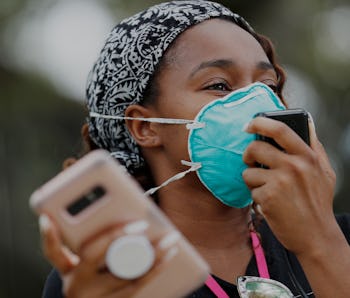Culture
This study figured out what type of homemade face masks actually work
Visualizing the spread and range of respiratory droplets can help us see which masks work — and which don't.

Despite repeated reminders from public health officials to wear face masks when we're outside, there aren't many detailed guidelines that can tell us which homemade masks work better than others.
In an effort to demonstrate the differences between different masks and the kind of shielding they can offer, a Florida Atlantic University study published by AIP Publishing gives us actual droplet visualization on the issue. It's quantitative analysis taken to another level with the help of a mannequin head that coughed and sneezed out droplets.
Well-fitted over loose knots — Right off the bat, researchers note that a mask's fitting has an unmistakable effect on how wide and far your respiratory droplets go. "Loosely folded face masks and bandana-style coverings provide minimal stopping-capability for the smallest aerosolized respiratory droplets," the authors of the study wrote. "Well-fitted homemade masks with multiple layers of quilting fabric, and off-the-shelf cone style masks, proved to be the most effective in reducing droplet dispersal."
It's actually more than six feet — So far, the running conventional wisdom is that a minimum of six feet helps with social distancing. That said, the researchers in the paper note that without a mask, your droplets can fly beyond the highlighted six feet, at times exceeding a distance of eight feet. Here are some materials, their jet distances, and how effective they are at limiting droplet transmission.
A bandana mask made out of elastic T-shirt material will limit the droplet range at three feet and seven inches. A folded handkerchief made of cotton will limit the jet distance to one foot and three inches.
A homemade stitched mask made of quilting cotton limits the jet distance around the mannequin head to two and a half inches.
A commercial mask that can be bought off store counters limits the jet distance to eight inches.
We need quantitative data with real-time visualization — Strange times call for creative solutions. A visual study like this gives us a tangible understanding of aerosolized respiratory droplets, their range, and infection potential.
As the researchers note, "35 percent of infected individuals" are asymptomatic and with the likelihood of a COVID-19 resurgence in fall and winter, helping the public understand what works and what doesn't is absolutely crucial.